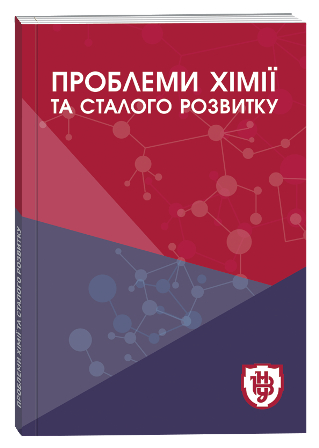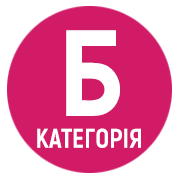CRYSTAL STRUCTURE OF ND3CU0.45GA1.52S7 AND ND3AG0.45GA1.52S7
DOI:
https://doi.org/10.32782/pcsd-2024-2-1Keywords:
rare earth metals, chalcogenides, crystal structure, X-ray powder methodAbstract
Samples of stoichiometric compositions of Nd3Cu0.45Ga1.52S7 and Nd3Ag0.45Ga1.52S7, weighing one gram each, obtained by sintering elementary components of a high degree of purity in vacuum quartz containers (the synthesis was carried out in vacuumed quartz ampoules to a residual pressure of 1.33·10-2 Pa) at the maximum synthesis temperature 1100 °С. The synthesized alloys were homogenized by annealing at a temperature of 500 °С for 500 hours. Crystal structure of sulfides Nd3Cu0.45Ga1.52S7 (a = 9.9354(6) Å, c = 6.0566(6) Å, V = 517.8(1) Å3, RI = 0.0832, Rp = 0.2640) and Nd3Ag0.45Ga1.52S7 (a = 9.9233(5) Å, c = 6.0724(5) Å, V = 517.8(1) Å3, RI = 0.0867, Rp = 0.2547) was studied by X-ray powder method. The studied structures relate to the structural type La3CuSiS7 (space group P63,173; Pearson symbol hP24). The Nd3Cu0.45Ga1.52S7 and Nd3Ag0.45Ga1.52S7 chalcogenide phases were synthesized on the basis of Nd3Ga1.67S7 sulfide by partial replacement of gallium atoms in the site 2b (1/3 2/3 z) point system with monovalent copper and silver atoms, respectively. In these structures, Neodymium atoms occupy site 6c (x y z) and, together with Sulfur atoms, form trigonal prisms with one additional atom [Nd S13S23S3] (CN = 7). Trigonal prisms form "blocks" 3[Nd 7S]. In these "blocks" trigonal prisms are connected to each other by ribs. Gallium Ga atoms occupy site 2a (0 0 z) and have an octahedral environment (for the Nd3Ag0.45Ga1.52S7 structure). In the Nd3Cu0.45Ga1.52S7 structure, Ga atoms have a triangular environment, since they are located near one of the faces of the octahedron. Octahedra [Ga (site 2a) 6S] have common faces and form columns in the direction of the c axis. These octahedra with trigonal prisms are connected by eddes. Atoms of statistical mixtures R1 (0.52 Ga + 0.45 Cu) and R2 (0.52 Ga + 0.45 Ag) are in the center of the tetrahedron [R1(R2) S13S3] formed from Sulfur atoms and occupy the site 2b (1/3 2/3 z) (CN = 4).
References
Mitchell K., Ibers J. Rare-Earth Transition-Metal Chalcogenides. Chem. Rev. 2002. 102. P. 1929–1952. https://doi.org/10.1021/cr010319h
Jean-Claude Bunzli, Pecharsky V. Handbook on the Physics and Chemistry of Rare Earths. Elsevier Science Publishers B. 2016. 50. 480.
Van Calcar P., Dorhout P. A study of new rare earth metal group 13 chalcogenides: structural chemistry and optical properties. Mater. Sci. Forum. 1999. 315. P. 322–330. https://doi.org/10.4028/www.scientific.net/MSF.315-317.322
Блашко Н., Марчук О., Федорчук А., Олексеюк І. Кристалічна структура сполук Ce3Ag0.45Ga1.52S7 та Pr3Ag0.45Ga1.52S7. Вісн. Ужгор. нац. ун-ту. Серія «Хімія». 2017. 1(37). C. 24–27.
Блашко Н., Марчук О., Смітюх О., Федорчук А. Кристалічна структура La3Pb0.1Ga1.6Se7 та Pr3Pb0.1Ga1.6Se7. Вісн. Ужгор. нац. ун-ту. Серія «Хімія». 2022. 2(48). C. 10–15. https://doi.org/10.24144/2414-0260.2022.2.10-15
Блашко Н., Марчук О., Смітюх О., Федорчук А. Кристалічна структура Pr3Ag4xGe1.25-xSe7 (x=0.10; 0.15). Вісн. Одеського ун-ту. Серія «Хімія». 2022. 27. 3(83). C. 27–35. https://doi.org/10.18524/2304-0947.2022.3(83).268609
Gulay L., Daszkiewicz M., Ruda I., Marchuk O. La2Pb(SiS4)2. Acta Cryst. C. 2010. 66(3). P. 19–21. https://doi.org/10.1107/S0108270110000247
Blashko N., Smitiukh O, Marchuk O. The crystal structure of La3Pb0.1Ga1.6S7 and La3Pb0.1Ga1.6S7 compounds. Physics and chemistry of solid state. 2022. 23(1). P. 96–100. https://doi.org/10.15330/pcss.23.1.96-100
Rudyk B., Stoyko S., Oliynyk A., Mar A. Rare-earth transition-metal gallium chalcogenides RE3MGaCh7 (M = Fe, Co, Ni; Ch = S, Se). J. Solid State Chem. 2014. 210. P. 79–88. https://doi.org/10.1016/j.jssc.2013.11.003
Ping Feng, Jia-Xiang Zhang, Mao-Yin Ran, Xin-Tao Wu, Hua Lin, Qi Long Zhu. Rare-earth-based chalcogenides and their derivatives: an encouraging IR nonlinear optical material candidate. Chemical Science. 2024. 15(16). P. 5869–5896. https://doi.org/10.1039/d4sc00697f
Linfeng Dong, Shengzi Zhang, Pifu Gong, Lei Kang, Zheshuai Lin. Evaluation and prospect of Mid-Infrared nonlinear optical materials in f0 rare earth (RE = Sc, Y, La) chalcogenides Coordination Chemistry Reviews. 2024. 509. 215805 https://doi.org/10.1016/j.ccr.2024.215805
Wang Y., Shi Y., Lin Y., Chen Z., Li L. Synthesis, Structure, and optical properties of Y3GaGe0.5S7: A new member in the polar R3MTQ7 family Inorg. Chem. Commun., 2023. 153. 110829 https://doi.org/10.1016/j.inoche.2023.110829
Hua-Jun Zhao. Synthesis, Crystal and Electronic Structure, and Optical Property of the Quaternary Selenide: La3Sb0.33SiSe7. Z. Anorg. Allg. Chem. 2015. 641. 917. http://dx.doi.org/10.1002/zaac.201500044
Grin Y., Akselrud L. WinCSD: Software package for crystallographic calculations (Version 4). J. Appl. Cryst. 2014. 47(2). Р. 803–805. https://doi:10.1107/s1600576714001058
Momma, K., Izumi, F. VESTA 3 for three-dimensional visualization of crystal, volumetric and morphology data. J. Appl. Cryst. 2011. 44(6). Р. 1272–1276. https://doi:10.1107/S0021889811038970
Patrie M., Guittard M. Chimie minerale. Sur les composes du type Ce6Al10/3S14, C. R. Acad. Sci., C, 1969. 268, 1136–1138.
Keiserukhskaya L., Luzhnaya N., Karaev Z. The system of Nd2S3–Ga2S3. Inorganic Materials (see: Izv.Akad. Nauk, Neorg.Mater.) 1970. 6(10). P. 1869–1871.
Choudhury A., Dorhout P. Alkali-Metal Thiogermanates: Sodium Channels and Variations on the La3CuSiS7 Structure Type. Inorg. Chem. 2015. 54. P. 1055–1065. https://doi.org/10.1021/ic502418s
Guittard, M., Julien-Pouzol M. Les composes hexagonaux de type La3CuSiS7. Bull. Soc. Chim. Fr. 1972. 3. P. 2207–2209.
Wiberg N, Wiberg E, Holleman A. Lehrbuch der Anorganischen Chemie. Walter de Gruyter. 102. Auflage, 2007. P. 2003–2004.







